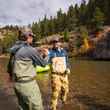“It really is about multiple use and multiple use is grazing, timber management, recreation, being able to use in some places four-wheel drives.”
“As the chief steward of our public lands, it is my responsibility to ensure that these lands are used for the benefit and enjoyment of the people.”
Those are the words of Ryan Zinke, secretary of the Interior Department, in statements explaining his recommendations to vastly shrink the Bears Ears and Grand Staircase Escalante national monuments in Utah.
In the months since Zinke uttered those words and many similar justifications for the Trump administration’s illegal actions shrinking Bears Ears and Grand Staircase Escalante national monuments, a trove of evidence has come to light that demonstrates that Zinke knowingly and intentionally misled the public, not only about the reasons behind his decision to recommend the monuments’ reductions but also about Trump’s motivations for ordering the monument review shortly after taking office.
The Story
Facing criticisms from sportsmen and conservationists, Zinke’s above claims of stewardship were in response to charges that his recommendations to shrink Grand Staircase Escalante by 47 percent and Bears Ears by a staggering 85 percent were not, in fact, motivated by a desire to “listen to the voices of the people” as he and others had repeatedly claimed. Rather, they formed part of an effort to open up land protected inside the two national monuments to coal, oil and gas extraction and uranium mining; the fruits of years of lobbying efforts at both the federal and state levels by the fossil fuel and mining industries.
But Zinke and Utah state officials such as Rep. Rob Bishop and Gov. Gary Herbert repeatedly labeled such accusations as “silly narrative[s]” predicated on false information, instead claiming that there were no known energy reserves worth exploring in either Bears Ears or Grand Staircase Escalante.
“I’ve heard this argument about Bears Ears’ oil and gas; that’s a nefarious argument … there are no oil and gas resources that anyone has reported in Bears Ears,” Zinke said.
Instead, Zinke said, it was necessary to shrink Utah’s iconic national monuments in order to undo overreach by presidents Clinton and Obama in establishing Grand Staircase Escalante and Bears Ears, which “restrict[ed] access for outdoor recreation on land that belongs to all of us.” With what has since been revealed to be staggering audacity, Zinke continued, proclaiming that Trump’s actions in requesting the monument review and accepting Zinke’s recommendations were “prioritizing the voice of the people over that of the special interest groups.”
The Proof is in the Emails
“We've long known that Trump and Zinke put polluter profits ahead of our clean air, clean water [and] public health ... This is more proof ... evidence of just how embedded Trump and Zinke are with the dirty energy of the past could not be clearer.”
That’s Alex Taurel of the League of Conservation Voters, responding to the March release of thousands of pages of Department of Interior emails and documents which left little doubt about the true intentions behind Trump and Zinke’s monument review and confirmed how deliberately Zinke and others in the Trump administration were willing to deceive the American people.

The emails and documents were released as part of a lawsuit filed by the New York Times, after the DOI had failed to respond to an open records request seeking the information. The materials unearthed a litany of clear ties to industry and revealed that many of Zinke’s recommendations in redrawing the borders of Bears Ears and Grand Staircase Escalante were taken nearly directly from requests made by industry representatives.
One email, sent from Senator Orrin Hatch’s office to the DOI prior to Zinke’s review included a map proposing revised boundaries for Bears Ears with the instruction that “this new boundary depicted on the map would resolve all known mineral conflicts for SITLA within Bears Ears.”

SITLA, a Utah state agency, focuses intently on maximizing fossil fuel and mineral extraction on public lands under its jurisdiction and has been criticized heavily for a management strategy that fails to take into account the public good and instead seeks to maximize profit for state and private interests.
Also revealed by the March email and document release was a memo produced by DOI staff members that detailed large coal reserves that were protected inside Grand Staircase and thus unavailable for extraction by private industry. According to the memo, "The Kaiparowits plateau, located within the monument, contains one of the largest coal deposits in the United States." According to the authors of the memo, approximately 11.36 billion tons of coal would be "technologically recoverable," if the plateau was excluded from protection within Grand Staircase Escalante national monument.

Throughout the released emails and documents, similar communications are laid bare. Another memo directs additional examination of the monuments, focusing intently on “annual production of coal, oil, gas and renewables (if any) on site; amount of energy transmission infrastructure on site (if any).” One communication requests information on how preservation of lands within the monuments may have “affected mining.” Other information documents meetings between DOI officials and executives and lobbyists from uranium mining companies.
The Devil is in the Details
This week, Zinke’s Department of the Interior released two new BLM (Bureau of Land Management) draft management plans for public lands in Utah, including lands cut from Utah’s national monuments by Trump’s executive action.
Even the most superficial examination of the BLM’s plans make clear the department’s intentions. The plans leave no room for interpretation, as they, as a matter of procedure, declare the department’s preferred alternative for ongoing management of these lands—increased development by private fossil fuel and mining interests.
From the Executive Summary of the BLM’s proposed plan for Grand Staircase Escalante national monument and surrounding (formerly monument-protected) lands:
Alternative D (Preferred Alternative)
Alternative D emphasizes resource uses and reduces constraints while ensuring the proper care and management of monument objects and maintaining compliance with existing laws and regulations designed to protect physical, biological, cultural, and visual resources. Compared to other alternatives, Alternative D conserves the least land area for physical, biological, and cultural resources; designates no ACECs or SRMAs; and is the least restrictive to energy and mineral development.
Also included with the BLM’s plans is an expansive, 100-page report on mineral potential within the lands cut from Grand Staircase Escalante, which details the availability of a large variety of minerals, coal, oil, tar sands, uranium, sand, and gravel.
Reaction from sportsmen and conservationists has been swift and unflinching.
Chris Staeger, executive director of the Western Values Project, said “We know that both these monument reductions were made at the behest of the same special interests and extractive corporations that brought the Trump administration into office. The administration should wait for legal challenges to the reductions to have their day in court before Secretary Zinke tries to open up stolen land to corporate land barons and sell off our protected lands to the highest bidder.”
Ryan Busse, North American board chair for Backcountry Hunters & Anglers said the BLM's draft plans represented a call to action for sportsmen, noting that "it’s clear that these monument reductions were made at the behest of extractive industries and at the expense of hunters and anglers. Sadly this continuing dishonest approach to policy is harming our long and rich national outdoor tradition. I call on all principled conservationists to stand and fight."
What Comes Next
As with Zinke’s initial review, the government has opened a 90-day comment period allowing Americans to voice their opinions on what course of action the BLM and DOI should take in managing the public lands in and around Bears Ears and Grand Staircase Escalante national monuments.
But, given Zinke and the DOI’s complete disregard of public comments surrounding the monument review, there is little reason to have faith that this latest comment period is anything more than smoke and mirrors.

Jesse Prentice-Dunn, advocacy director for the Center for Western Values, perhaps put it best, noting “This request for public input is a sham and there’s little doubt the American public is prepared to let the Trump administration know as much. When the administration asked Americans whether they should alter national monuments during a comment period last year, more than 2.8 million — more than 99 percent of comments submitted — asked them to leave our national monuments alone.”
“Just as it has all along, this Interior Department will ignore Americans who want to see these monumental landscapes protected, and bulldoze its way forward with plans to throw open the gates for more mining, logging, and drilling. Luckily, the courts will have the ultimate say.”
For Zinke’s critics, who have long highlighted his strong ties to the fossil fuel industry—Zinke amassed over $300,000 in industry campaign contributions in only 2 years as a Montana congressman and repeatedly voted in lock-step with fossil fuel interests, compiling a disastrous 4 percent rating from the League of Conservation Voters— the revelations of the past 6 or so months have come as little surprise.
Rose Marcario, CEO of Patagonia—which has been one of the most influential and active critics of the Trump administration's attacks on public lands—told Hatch Magazine that "transferring public lands to the states as a way to protect them for hunters, anglers and hikers makes as much sense as cutting down trees to protect local communities. It sure didn’t take long for Secretary Zinke to sell his Montana roots to extractive industry millionaires and foreign developers. This November, we will be working to elect leaders who will protect our public lands and waters and hold politicians like Secretary Zinke accountable"
For those individuals and organizations that failed to challenge or, worse, applauded Zinke’s appointment—portraying Zinke as committed to the preservation of public lands and the protection of fish and wildlife habitat despite the reality that, long before Zinke’s appointment to lead the Interior, the facts betrayed that portrayal—it serves as a continued call to action for these same individuals and groups to now, in the strongest terms, demand an investigation into Zinke’s industry ties and call for the Secretary to step down from his post. The time for silence and mild rebukes has long since past.
































Comments
Maggie Frazier replied on Permalink
Very informative article! One of many that all tell the same story - the goal of this administration is nothing more than to get what they can while they can - no matter what kind of destruction is done to our environment, air, water, wildlife or its habitat. Nature is their enemy! Anything not in their control is to be feared!
Unless all of us wake up & fight this attempt to eradicate our natural environment - there will be no monuments, parks or wildlife refuges left. Is that what we American citizens really want?
Matt replied on Permalink
Don’t need more evidence at this point...the verbiage of the actual resolution is clear enough. Give us some advice on who to vote for, where to put $$, etc...
JJ Canz replied on Permalink
Sadly this administration just doesn't get at any level.......allowing the exploitation of our natural resources reminds of an era of American history when the lands were raped and the resources were pillaged. Our leaders must wake up......natural resources cannot be restored.
Political action to correct the leadership is required next election.
Joe replied on Permalink
Shocker... Who wants to guess on Zinkes title at BP once hes out of office?
Senior Independent Consultant
Vice-Chairman of the Board
fill in: __________________
Pages